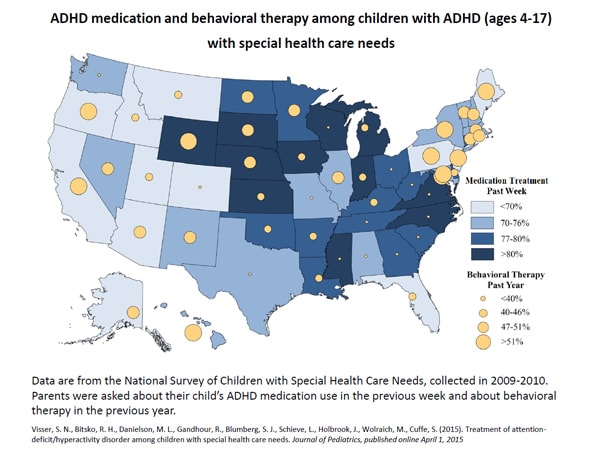Atlanta, GA–(ENEWSPF)–April 1, 2015. The first national study to look at behavioral therapy, medication, and dietary supplements to treat attention-deficit/hyperactivity disorder (ADHD) among children ages 4-17 shows that less than one half of children with ADHD were receiving behavioral therapy in 2009-2010.
 ADHD medication and behavioral therapy among children with ADHD (ages 4-17) with special health care needs
ADHD medication and behavioral therapy among children with ADHD (ages 4-17) with special health care needs
Entire Infographic
According to the study, among children 4-17 years of age, about 4 in 10 children with ADHD were treated with medication alone, 1 in 10 received behavioral therapy alone, 3 in 10 were treated with both medication and behavioral therapy, and 1 in 10 received neither medication nor behavioral therapy. Overall, about 1 in 10 children took dietary supplements for ADHD.
The data show that 1 in 2 preschoolers ages 4-5 with ADHD received behavioral therapy and about 1 in 2 were taking medication for ADHD. Almost 1 in 4 preschoolers were treated with medication alone. Among children ages 6-17 with ADHD, fewer than 1 in 3 received both medication and behavioral therapy.
“We do not know what the long-term effects of psychotropic medication are on the developing brains and bodies of little kids. What we do know is that behavioral therapy is safe and can have long-term positive impacts on how a child with ADHD functions at home, in school, and with friends,” said CDC Principal Deputy Director Ileana Arias, Ph.D. “Because behavioral therapy is the safest ADHD treatment for children under the age of 6, it should be used first, before ADHD medication for those children.”
In 2011, AAP released ADHD treatment guidelines recommending behavioral therapy alone for treatment of preschoolers and combination therapy of medication and behavioral therapy for children with ADHD between the ages of 6-17.
“Treatment decisions for ADHD in children can be complex. Parents, health professionals, psychologists, and educators can work together to ensure that children receive the best treatment available,” said Susanna Visser, DrPH, M.S., epidemiologist with CDC’s National Center on Birth Defects and Developmental Disabilities. She added, “The good news is that we now have strong clinical guidelines to support the more than 5 million children living with ADHD.”
The study shows significant state-to-state variability in the type of treatment used to treat ADHD in children 4-17 years of age. On average, states with higher behavioral therapy rates had lower medication treatment rates and vice versa. Rates of medication treatment among children with ADHD ranged from a low of 57 percent in California to a high of 88 percent in Michigan. Rates of behavioral therapy among children with ADHD ranged from a low of 33 percent in Tennessee to 61 percent in Hawaii. This analysis was from parent reported data from the 2009-2010 National Survey of Children with Special Health Care Needs.
For a copy of the full article visit: http://www.jpeds.com/pb/assets/raw/Health%20Advance/journals/ympd/Visser.pdf.
Additional Information on ADHD:
ADHD is one of the most common chronic conditions of childhood. It often persists into adulthood. Children with ADHD may have trouble paying attention and/or controlling impulsive behaviors. When children diagnosed with ADHD receive proper treatment, they have the best chance of thriving at home, doing well at school, and making and keeping friends.
CDC monitors the number of children who have been diagnosed with ADHD through national survey data and community based studies. Including questions about ADHD on national or regional surveys helps CDC learn more about the number of children with ADHD, their use of ADHD treatments, and the impact of ADHD on children and their families. Learn more at www.cdc.gov/adhd.
For more information on the American Academy of Pediatrics guidelines on diagnosing, evaluating and treating ADHD visit http://www.cdc.gov/ncbddd/adhd/guidelines.html
The National Resource Center on ADHD, a program of CHADD (Children and Adults with Attention-Deficit/Hyperactivity Disorder) and supported by CDC, is the national clearinghouse for the latest evidence-based information on ADHD. The Center provides comprehensive information and support to individuals with ADHD, their families and friends, and the professionals involved in their lives, www.help4adhd.org
Source: cdc.gov








